A great-granddaughter recalls the pioneering spirit and artistic achievements of her unorthodox ancestor. 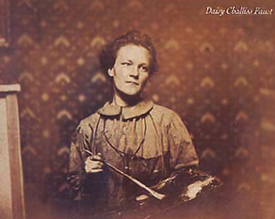
Family lore has it that my great-grandmother Daisy Challiss Faust tied her daughter, my grandmother, to a tree while she painted. Endlessly retold (usually to impress young minds, such as my own, what a mistake it is to choose a life devoted to art ), the story attained mythical proportions. It even reached the point that my aunt, who recently visited Atchison, Kansas, where Daisy was born in 1867, claims to have seen the actual tree. Outside of this story, however, my older relatives are mute; the idea that a woman would pursue her art without the possibility of recognition and lead a life according to her own dictates seems to embarrass them to this day.

But for me, an artist who grew up outside Chicago in the Eisenhower '50s, -a time when all the women I knew were housewives, nurses, or teachers - just knowing I'd had a relative like Daisy (as well as her cousin's famous daughter, Amelia Earhart) helped me shake my suburban torpor. Although she died before I was born, Daisy was very much present in the art that filled our tiny ranch house and in the letters, photos, and memorabilia of an extraordinarily well-documented family. Over the piano where I practiced every day were matching oil portraits Daisy did of her parents, and over my mother’s desk hung what looked like an oil painting of the Challiss family’s log-cabin vacation home. But if you looked closely you could see the picture was made of various brightly patterned pieces of cloth, sewn together with tiny stitches. By the window sat a life-size plaster bust of my mother as a young girl, painted silver. There was also a hooked rug, intricately worked to depict a hearth and roaring fire; Daisy had made it out of her own discarded silk stockings, dyeing each a different color. As a child I took these things for granted, but the more I learned about art the more I came to appreciate Daisy's formidable talent. Yet in her time she was recognized only for her most conventionally feminine efforts: painted flowers on china, exhibited at the World's Fair of 1893. Daisy’s parents, Dr. William snd Mary Challiss, were pioneers of a sort, who migrated from a comfortable life in Philadelphia to Atchison when the latter was barely a village. Dr. Challiss and his brother Luther founded and ran the first ferry service across the Missouri River.
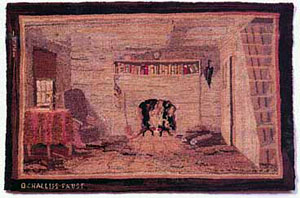 “Daisy’s love for art cropped up early," wrote her sister in a letter. "She licked the paints in someone’s watercolor box and was pretty sick." From all accounts the childhood of the ten Challiss children was idyllic, and Daisy was considered, even by her mother, to be the most beautiful of the seven sisters. When, at twenty-two, she married a merchant from Philadelphia named Harry Faust, the Atchison paper wrote, "It is not extravagant to say that Miss Challiss ... was, in every respect, one of the most beautiful brides ever seen in this city.”
“Daisy’s love for art cropped up early," wrote her sister in a letter. "She licked the paints in someone’s watercolor box and was pretty sick." From all accounts the childhood of the ten Challiss children was idyllic, and Daisy was considered, even by her mother, to be the most beautiful of the seven sisters. When, at twenty-two, she married a merchant from Philadelphia named Harry Faust, the Atchison paper wrote, "It is not extravagant to say that Miss Challiss ... was, in every respect, one of the most beautiful brides ever seen in this city.”
Although she maintained a great affection for her family and nostalgia for her childhood – her favorite subjects for her pictures were her parents and the family homestead - Daisy felt herself different. “I was always considered the queer one of the family," she wrote. "Almost everything I said or did was accompanied with 'Queer Daisy' but those things did not seem queer to me. I was the seventh daughter, and I married a seventh son – that was queer." When Daisy and Harry moved to Philadelphia in 1889, she began studying at the Pennsylvania Academy of Fine Art. She must have found a market for her paintings, because she wrote: “I want to do a great deal or work this summer to carry me through my studies next winter. I have been doing this ever since I have been married. Harry does not have to put out one cent on my art."
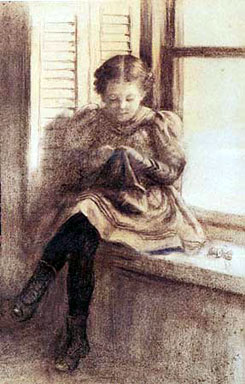
Their only child, Marguerite, who Daisy called Sweetheart, was born in 1890, but having a child did not keep Daisy from painting. In a letter describing the famous tree stratagem (which, unless there were two trees, places it in Philadelphia), Daisy gives an account of her activities: " I attend the Academy every morning and rush home at noon, eat my lunch, and Sweetheart and I go to the Zoo. The keepers are as much interested in her as when she was the 'Zoo Baby', and can hardly believe her to be the same whom I used to tie to the tree just five years ago.”
By the time she was in her thirties, Daisy had become a widow. She also dislocated her neck, a newspaper account says, "while attempting to stand on her head." It was a serious injury, leaving her with "no control over the movement of her head.” She was ultimately cured by chiropractic treatments, which so impressed her that she decided to become a chiropractor. She wrote that her goal was "to devote the rest of my life to relieving suffering humanity as I was relieved."
Not long after she opened a practice in Philadelphia a newspaper article reported that “she enjoys a handsome income from her profession. She has all she can do and has waiting list of fifty or more patients all the time. Dr. Faust lost her husband some years ago and she is dependent upon her efforts for support of herself and her child."
Grateful patients left property to her in their wills, including a beach house in Avalon, New Jersey and a large estate at Lake George, New York, where my mother remembers spending many summers. Daisy also designed and built a cottage in Avalon, from the ground up, hammering every nail herself. The house was a perfect square, with a porch running all around it and a chimney in the middle. My mother told me that Daisy painted the chimney yellow, the roof in colorful concentric stripes, and named the house Sunnytop.
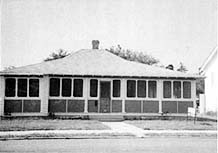
The rag pictures, as Daisy called them, of scenes from her childhood, were done in Los Angeles, where she lived in the '20s. She worked on them late at night, after office hours, and the larger ones took more than a month to complete. There is a tiny notice in the Los Angeles Times of an exhibit at a local art league, but while she said she had many more requests to exhibit them, she refused because the images of her childhood meant too much to her. Instead, she sent them to each of her sisters and brothers, who were by this time scattered across the country.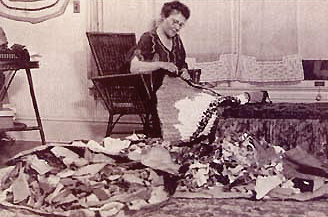
I've been led to believe that having such an unconventional mother caused my grandmother, who died when I was two, a trauma from which she never recovered. The biggest shock, however, occurred when Daisy, probably in the ‘30s, became a follower of a religious movement founded by the black preacher known as Father Divine. The movement claimed millions of followers, black and white, who were called "angels." They lived well and ate sumptuously in communal "heavens" - their term for estates, hotels, and businesses bought or donated by the flock. Father Divine himself owned nothing.
Preaching racial equality, members greeted each other by saying "Peace, it's wonderful," and took new names such as Blessed Faithful and Positive Love. They vowed to give up smoking, drinking, profanity, marriage, sex, and the receiving of gifts or tips.
Moving to Harlem at the height of the Depression, Father Divine's missions turned away no one. Free meals were given to the indigent, and inexpensive room and board was provided for those who could work. Jobs were sought through a chain of employment agencies. TIME magazine, in its obituary on Father Divine, called him "an upright man, honest and just," and Langston Hughes wrote in the New York Post: "Many thousands of people are better people for his having lived."
I'm sure Daisy, the daughter of an abolitionist, with her concern for "suffering humanity" (which my mother always felt outweighed her concern for her daughter and grandchildren), was attracted by Father Divine's charitable goals. This was, after all, a woman who was always sewing for the poor and treating patients "for love," and who, as a young bride arriving in Philadelphia, set to work establishing a Baptist mission; the Atchison newspaper, reporting on this activity, said, "It is just like her."
The Father Divine movement did not acknowledge death; in 1965, it even refused to commemorate its founder's own passing, at nearly 100 years of age. As a result, although it is known that Daisy died in New York, no details about her death have ever come to light, not even the date.
Daisy was a woman before her time; she even looked it. In group photographs with her brothers and sister’s, everyone else looks hopelessly old-fashioned while she appears contemporary. But her immediate family seems to have accepted her more readily than her daughter and my mother did. Now I see my mother's conservatism, her concern over my lack of convention and her often-expressed fear that I’d become a person who was about "art for art's sake," as a reaction to her grandmother. I'm not quite sure what "art for art's sake" means, but I'm afraid it's what I’ve come to. Daisy, at least, would have approved.
-Carol Diehl